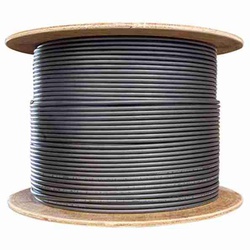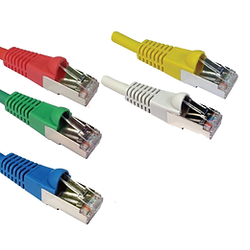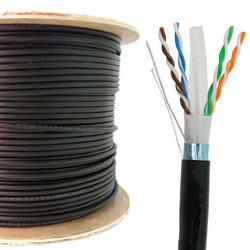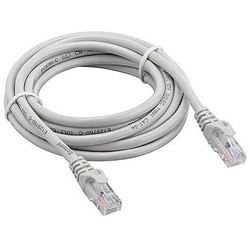
Giganet Cat 6A Cable U/UTP Indoor
by Giganet
The Giganet Category 6A F/UTP ‐ foil screened ‐ cables are manufactured and tested to the ANSI/TIA-568.2-D, ISO/IEC11801-1, and EN 50173-1 Category 6A specifications. Each cable consists of 8 color-coded 23AWG polyethylene insulated, solid bare copper, conductors. These are twisted together to form 4 pairs with varying lay lengths.
- Foil Screened Construction: The cable follows a F/UTP construction, which stands for Foil Screened/Unshielded Twisted Pair. It means that the cable has an overall foil shielding layer that surrounds the twisted pairs of copper conductors. The foil shielding helps to reduce electromagnetic interference (EMI) and crosstalk, ensuring high-quality signal transmission.
- 23AWG Polyethylene Insulated Conductors: Each cable consists of eight color-coded conductors made of solid bare copper. The conductors are 23 American Wire Gauge (AWG) in size, indicating their diameter. The use of solid conductors provides stability and durability to the cable's performance.
- 4 Pairs with Varying Lay Lengths: The eight conductors are twisted together to form four pairs. Each pair has a unique lay length, which refers to the rate at which the twisted wires repeat their pattern. Varying the lay lengths helps to minimize crosstalk and interference, enhancing the overall performance of the cable.
| SKU | 1248 |
|---|
Reviews
Description
Giganet Cat 6A Cable U/UTP Indoor
The Giganet Category 6A F/UTP ‐ foil screened ‐ cables are manufactured and tested to the ANSI/TIA-568.2-D, ISO/IEC11801-1, and EN 50173-1 Category 6A specifications. Each cable consists of 8 color-coded 23AWG polyethylene insulated, solid bare copper, conductors. These are twisted together to form 4 pairs with varying lay lengths. These pairs are then formed around a central ‘X’ shaped polyethylene filler. This filler assists in maintaining and enhancing the cable’s performance. Clear Mylar tape is then wrapped around this unit and a foil tape screen with 24AWG drain wire applied. The foil screen provides protection from Electromagnetic Interference (EMI) which can occur when data is transmitted at high frequencies.
key features:
-
Foil Screened Construction: The cable follows a F/UTP construction, which stands for Foil Screened/Unshielded Twisted Pair. It means that the cable has an overall foil shielding layer that surrounds the twisted pairs of copper conductors. The foil shielding helps to reduce electromagnetic interference (EMI) and crosstalk, ensuring high-quality signal transmission.
-
23AWG Polyethylene Insulated Conductors: Each cable consists of eight color-coded conductors made of solid bare copper. The conductors are 23 American Wire Gauge (AWG) in size, indicating their diameter. The use of solid conductors provides stability and durability to the cable's performance.
-
4 Pairs with Varying Lay Lengths: The eight conductors are twisted together to form four pairs. Each pair has a unique lay length, which refers to the rate at which the twisted wires repeat their pattern. Varying the lay lengths helps to minimize crosstalk and interference, enhancing the overall performance of the cable.
-
Category 6A Performance: The cable is designed to support Category 6A performance, which means it can handle data transmission speeds of up to 10 gigabits per second (Gbps). It offers excellent bandwidth and performance, making it suitable for demanding network applications and environments.
-
Compliance with Standards: The cable meets the ANSI/TIA-568.2-D, ISO/IEC11801-1, and EN 50173-1 Category 6A specifications. These are internationally recognized standards that ensure the cable's performance, quality, and compatibility with network infrastructure.
-
Indoor Installation: The cable is intended for indoor use, typically in office buildings, data centers, or other indoor network installations. It may not be suitable for outdoor or direct burial applications.
-
Compatibility: The Category 6A F/UTP cable is backward compatible with previous Ethernet standards, including Cat 6, Cat 5e, and Cat 5. This allows it to be used in networks with older devices or infrastructure, although the maximum performance will be limited to the capabilities of the lowest category involved.






